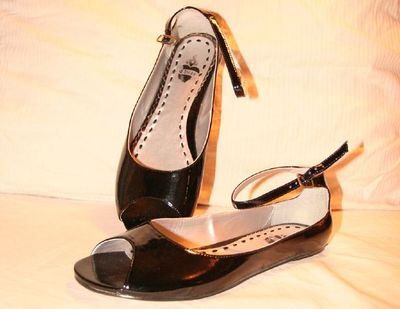Patent leather
Patent leather is leather that has been given a high gloss, shiny finish. The original process was developed by Newark, New Jersey-based inventor Seth Boyden in 1818 with commercial manufacture beginning September 20, 1819. His process used a linseed oil–based lacquer coating. Modern patent leather usually has a plastic coating.
Patent leather is sometimes confused with poromeric imitation leathers such as DuPont's Corfam and Kuraray Co]'s Clarino which are manmade materials with a similar glossy appearance.
Patent leather and poromerics are cleaned in a similar way. Dirt adhering to the coating can be removed with a damp cloth, using a mild soap if needed. Minor scratches and scuff marks in the coating itself can be removed using one of several special-purpose patent leather and poromeric cleaners on the market. With wear and tear, patent leather will eventually lose its glossy finish, but will still be smoother than most other types of leather, looking almost rubbery.
Patent leather and poromerics are used in applications where an eye-catching glossy appearance is the most important consideration. Examples include fashion items such as wallets and handbags, dance and uniform shoes, kinky boots and professional wrestling boots, and trench coats. In recent years patent leather has become a popular material for limited-edition sneakers.
History
The history of patent leather begins in the early 19th century and owes its invention to Seth Boyden of Newark, New Jersey. In 1818, Boyden began to investigate the possibility of creating a version of leather that was treated in such a way that the material would be decidedly more dressy than work boots and similar leather goods, but retained its desirable qualities of protection and durability.
Using a formula that was based on a series of treatments using layers of linseed oil-based coats, the new shiny leather began commercial production on 20 September 1819. Boyden’s efforts resulted in the production of glossy leather that quickly caught on as a complement for formal dress.
Patent leather begins as a superior grade of fine grain leather that undergoes a process to achieve the glossy look. Originally, this was accomplished by applying layers of a linseed oil finish to the leather, gradually creating the sleek appearance. Later, the invention of plastics changed the methods for producing patent leather.
Plastic finishes were able to produce effects similar to the application of several treatments with linseed oil, with the advantage of considerably less monetary investment on the part of the producer. Over time, the development of synthetic resins further simplified the process and cut production costs even further, making the mass production of patent leather possible.
Characterized by a glass-like finish that catches the light, patent leather is typically solid black. Patent leather may also come in several colors such as neutral tan, white, black or even neon colors such as neon-green and hot-pink.In addition to the mirror-like finish, patent leather is also virtually waterproof, while still retaining a very flexible texture. The visual aspects of patent leather have made it a sought-after material for formal accessories. Most men's footwear produced to be worn with tuxedos or with dress military uniforms is made of patent leather, and many formal types of heels for women are also produced using patent leather. Clutches and small handbags for women are also made using patent leather, as well as some formal wallets and cigarette cases. Patent leather has also seen popular use on sneakers.
Popular culture
In Agatha Christie's Poirot series of books, Poirot normally wears a pair of patent leather shoes (and in one of the episodes of the television version, tries to teach Hastings how to look after them).
In A Study in Scarlet, Sherlock Holmes identifies a foot print as being from a man wearing patent leather shoes.
| Leather can have various references: |
|---|
|
This article uses material from Wipipedia website
See Also
External links
Chat rooms • What links here • Copyright info • Contact information • Category:Root
